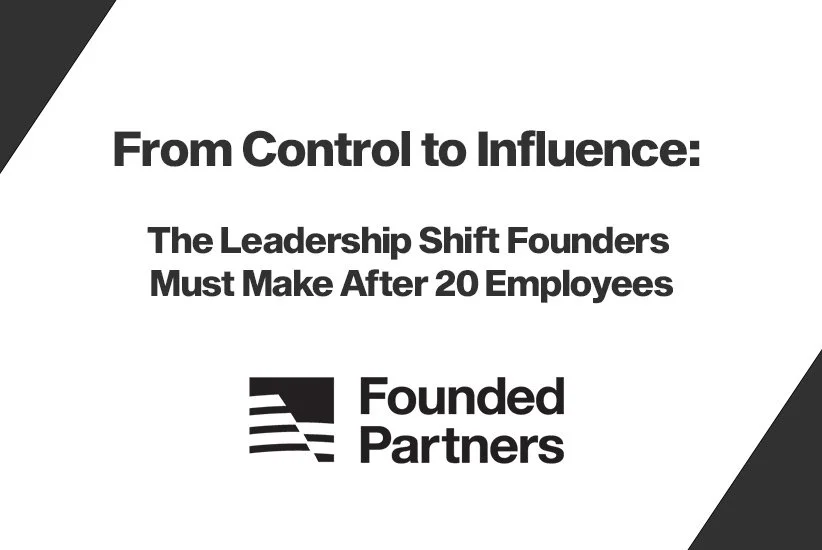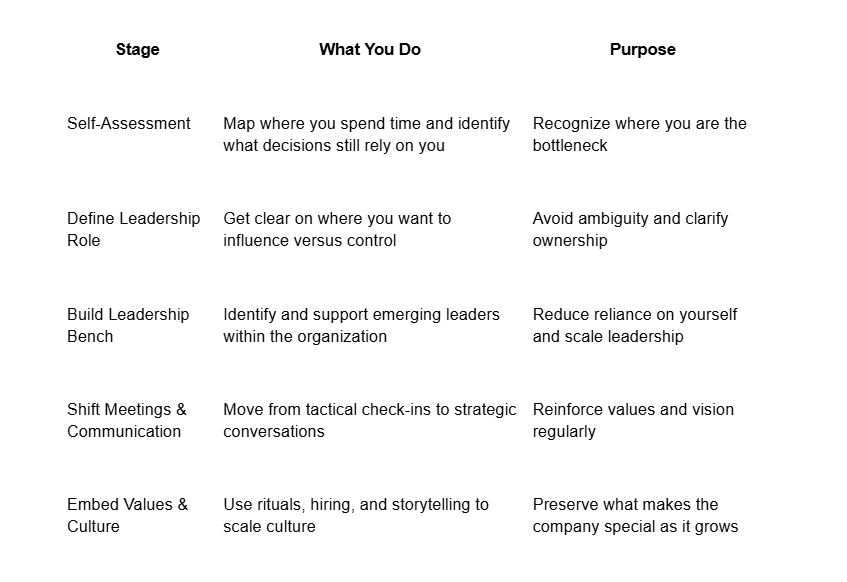From Control to Influence: The Leadership Shift Founders Must Make After 20 Employees
There comes a moment in every founder-led business when growth no longer relies on hustle, instinct, or the founder's direct involvement in every decision. That moment often arrives around the 20-employee mark. At this size, the company becomes something new: a layered, complex system where the founder's old ways of working begin to show cracks. What used to work now creates friction. Decisions are slow. Culture starts to drift. The founder feels stuck between doing everything and letting go of control.
This is not a failure. It’s a natural and necessary shift. The role of the founder must evolve from control to influence.
Why 20 Employees is a Pivotal Threshold
According to Larry Greiner's Organizational Growth Model, businesses go through phases of growth punctuated by crises. The first major crisis is the "leadership crisis," which happens as companies expand beyond their early creative stage. What causes the crisis? The founder's leadership style, once agile and hands-on, becomes a bottleneck. You cannot scale a business if every decision still flows through you.
As team size grows, so does complexity. Layers begin to form. Roles become more specialized. Suddenly, communication by osmosis no longer works. Not everyone hears the founder's thoughts at the lunch table. The culture starts to fragment. This is when the founder must make the most significant leadership pivot of their entrepreneurial journey.
It’s no longer about doing. It’s about leading.
The New Leadership Requirement: From Control to Influence
In the early days, many founders lean into directive leadership. They know the business inside-out, so they tell others what to do. This can work with 5 or 10 employees, but it doesn’t scale. Beyond 20, this style becomes a liability. The founder becomes the blocker instead of the driver.
To grow beyond this point, founders must shift toward what academics call "ambidextrous leadership" — the ability to balance structure and flexibility, control and creativity. This means learning to influence rather than control.
Influence is not passive. It is proactive, strategic, and powerful. It shows up through shared leadership, where influence is distributed across the team. It shows up through situational leadership, where the founder adapts their approach based on the context. It shows up in transformational leadership, where leaders inspire others, set vision, and align people around a purpose. It shows up in how founders create space for other leaders to rise.
In short, founders move from being the centre of gravity to being the force that shapes the culture, strategy, and rhythm of the business without micromanaging every detail.
What It Looks Like to Make the Shift
Moving from control to influence is not just philosophical. It requires concrete behavioural and structural changes.
Instead of dictating tasks, founders start hosting strategic conversations. They shift from solving every problem to asking better questions. Instead of leading every meeting, they mentor those who do. Instead of being the first to speak, they become the last.
Leadership becomes a practice of clarity and coaching. Founders help others make better decisions, rather than making all the decisions themselves. They model the behaviours they want the rest of the organization to emulate.
The goal is to unlock distributed leadership. When influence is scaled across the team, the organization becomes more resilient, more innovative, and more adaptable. This is what separates a $5 million business from a $50 million one.
How to Transition Without Losing Culture
One of the greatest fears founders face during this transition is losing their culture. When you let go of control, how do you ensure the company still feels like yours?
The key is to shift from a founder-led culture to a values-led culture.
Start by making your values explicit. Codify what matters most. Don’t rely on everyone "just knowing" the culture. Write it down. Share stories that show your values in action. Reinforce them in meetings, hiring, onboarding, and performance reviews.
Edgar Schein, a leading scholar on organizational culture, explains that culture operates on three levels: artifacts (what people see), values (what people say), and underlying assumptions (what people believe). As the founder moves into a more influential role, they must focus on all three. Rituals, symbols, decisions, and language all communicate culture.
To preserve culture as you grow, create mechanisms that reinforce it. Assign culture ambassadors. Start team rituals. Make your values part of decision-making frameworks. And most importantly, live those values yourself.
This isn’t just about culture. It’s also about building leadership capacity in others.
Start developing your leadership bench. Identify high-potential team members. Give them autonomy. Let them make decisions and learn. Coach them. This creates a ripple effect of leadership throughout the company.
Structure helps too. As the company grows, set up systems that scale culture and communication. Weekly updates. Monthly all-hands. Value-based hiring rubrics. These touchpoints help retain the core of who you are, even as the company matures.
A Practical Transition Plan for Founders
Here is a step-by-step framework founders can follow to manage this transition:
Common Pitfalls to Avoid
Many founders resist this transition. They hold on to control too long. They tell themselves, "No one can do it like I can." Maybe that’s true, but it’s also unsustainable.
One common trap is when founders keep voting or equity control but step back operationally without investing in leadership. This creates a power vacuum and demoralizes the team.
Another trap is hiring leaders and then not letting them lead. Delegating authority without ownership leads to frustration and turnover.
Finally, some founders allow culture to drift by failing to be intentional. They add new team members who are competent but not aligned. They scale too fast without reinforcing what made the company special in the first place.
These mistakes are avoidable. But only if the founder is willing to let go of control and step into a new kind of leadership.
What You Gain By Making the Shift
Making the shift from control to influence unlocks a new level of scale, freedom, and fulfillment.
You create space for innovation. Teams that are empowered solve problems faster and bring better ideas forward.
You increase engagement and retention. When people feel trusted and supported, they stay and grow with the company.
You build a business that does not rely solely on you. This is essential if you want to sell, raise capital, or eventually exit.
Most importantly, you evolve as a leader. You stop playing founder and start playing builder.
This is not just the next phase of your company. It’s the next phase of your leadership.
The Moment to Begin is Now
You do not need to wait for the chaos to hit. If you’re approaching 20 employees – or already there – now is the time to prepare.
Start by reflecting on where you still hold control. Begin codifying your values. Clarify your role as a leader. Develop your people. Shift your mindset from being at the centre of every decision to being the architect of a system that runs without you.
Because real leadership isn’t about how many decisions you make. It’s about how many leaders you create.
Ready to Make the Shift?
If your company is growing and you're approaching this pivotal stage, Founded Partners can help you navigate the transition with clarity and confidence. Reach out today to explore how Founder Advisory can support your leadership evolution while preserving your company’s unique culture.


